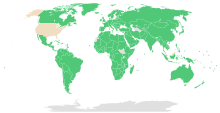The Stockholm Convention on Persistent Organic Pollutants is an international treaty signed in 2001. The treaty became effective in May 2004. Its aim is to limit the use and production of Persistent Organic Pollutants. Examples of substances affected by the treaty are Polychlorinated biphenyl and Dichlorodiphenyltrichloroethane. An extension to the treaty in 2009 added other substances, like Lindane. Critics have said that the treaty limits the effectiveness of the fight against diseases such as malaria. This is not the case, as the use of certain substances for vector control is permitted; this includes the use against mosquitoes.[1][2][3]


State parties to the Stockholm Convention as of 2016
Chemicals listed
changeThe following chemicals are listed:
| Annex | Name | CAS Number | Exceptions |
|---|---|---|---|
| A. Elimination | Aldrin | 309-00-2 | Production none Use as a pesticide |
| A. Elimination | Chlordane | 57-74-9 | Production by registered parties Use as a local ectoparasiticide, insecticide, termiticide (including in buildings, dams and roads) and as an additive in plywood adhesives |
| A. Elimination | Dieldrin | 60-57-1 | Production none Use in agricultural operations |
| A. Elimination | Endrin | 72-20-8 | None |
| A. Elimination | Heptachlor | 76-44-8 | Production none Use as a termiticide (including in the structure of houses and underground), for organic treatment and in underground cable boxes |
| A. Elimination | Hexachlorobenzene | 118-74-1 | Production by registered parties Use as a chemical intermediate and a solvent for pesticides |
| A. Elimination | Mirex | 2385-85-5 | Production by registered parties Use as a termiticide |
| A. Elimination | Toxaphene | 8001-35-2 | None |
| A. Elimination | Polychlorinated biphenyls (PCBs) | various | Production none Use in accordance with part II of Annex A |
| B. Restriction | DDT | 50-29-3 | Disease vector control in accordance with Part II of Annex B Production and use as an intermediate in the production of dicofol and other compounds |
| C. Unintentional Production | Polychlorinated dibenzo-p-dioxins ("dioxins") and polychlorinated dibenzofurans | various | |
| C. Unintentional Production | Polychlorinated biphenyls (PCBs) | various | |
| C. Unintentional Production | Hexachlorobenzene | 118-74-1 |
References
change- ↑ Curtis, C. F. (2002), "Should the use of DDT be revived for malaria vector control?", Biomedica, 22 (4): 455–61, doi:10.7705/biomedica.v22i4.1171, PMID 12596442.
- ↑ 10 Things You Need to Know about DDT Use under The Stockholm Convention (PDF), World Health Organization, 2005.
- ↑ Bouwman, H. (2003), "POPs in southern Africa", Handbook of Environmental Chemistry. Vol. 3O: Persistent Organic Pollutants, pp. 297–320, archived from the original on 2007-10-10, retrieved 2011-05-28.